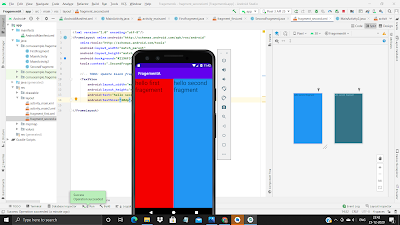Fragments-
We can understand fragment by an example, Suppose we have an Activity A . when we want to perform another task on another screen then we have to create another Activity (navigation between two activities). These is traditional navigational method so far before android 3.0. But this time we have fragment. We can use fragments instead of Activity.
Fragment is the sub-part of the activity. We can create more then one fragment in an activity.
Fragment is like a screen. Fragment represent multiple screen inside one activity.
We can reuse same fragment in several activities, because fragment have their own layout which can be used across the many different activities.
1.Static Fragment-
If we want to create a screen in which no need to any type of change then we use static fragment.
for create static fragment-
1.First create project.
2.Create main activity(Empty)
3.Create FirstFragment(blank)
4.Create SecondFragment(blank)
When you create main activity, firstfragment and secondFragment by deafault you get there .xml file also.
code for main activity
package com.example.fragementa;
import androidx.appcompat.app.AppCompatActivity;
import android.os.Bundle;
public class MainActivity extends AppCompatActivity {
@Override
protected void onCreate(Bundle savedInstanceState) {
super.onCreate(savedInstanceState);
setContentView(R.layout.activity_main);
}
}
code for main.xml
<?xml version="1.0" encoding="utf-8"?>
<LinearLayout xmlns:android="http://schemas.android.com/apk/res/android"
xmlns:app="http://schemas.android.com/apk/res-auto"
xmlns:tools="http://schemas.android.com/tools"
android:layout_width="match_parent"
android:layout_height="match_parent"
android:background="#108BEC"
tools:context=".MainActivity">
<fragmentandroid:layout_width="0dp"
android:layout_height="match_parent"
android:name="com.example.fragementa.FirstFragment"
android:id="@+id/frg1"
android:layout_weight="1"
></fragment>
<fragment
android:layout_width="0dp"
android:layout_height="match_parent"
android:name="com.example.fragementa.SecondFragment"
android:id="@+id/frg2"
android:layout_weight="1"
></fragment>
</LinearLayout>
code for FirstFragment
java file-
package com.example.fragementa;
import android.os.Bundle;
import androidx.fragment.app.Fragment;
import android.view.LayoutInflater;
import android.view.View;
import android.view.ViewGroup;
public class FirstFragment extends Fragment {
// TODO: Rename parameter arguments, choose names that match
// the fragment initialization parameters, e.g. ARG_ITEM_NUMBER
private static final String ARG_PARAM1 = "param1";
private static final String ARG_PARAM2 = "param2";
// TODO: Rename and change types of parameters
private String mParam1;
private String mParam2;
public FirstFragment() {
// Required empty public constructor
}
// TODO: Rename and change types and number of parameters
public static FirstFragment newInstance(String param1, String param2) {
FirstFragment fragment = new FirstFragment();
Bundle args = new Bundle();
args.putString(ARG_PARAM1, param1);
args.putString(ARG_PARAM2, param2);
fragment.setArguments(args);
return fragment;
}
@Override
public void onCreate(Bundle savedInstanceState) {
super.onCreate(savedInstanceState);
if (getArguments() != null) {
mParam1 = getArguments().getString(ARG_PARAM1);
mParam2 = getArguments().getString(ARG_PARAM2);
}
}
@Override
public View onCreateView(LayoutInflater inflater, ViewGroup container,
Bundle savedInstanceState) {
// Inflate the layout for this fragment
return inflater.inflate(R.layout.fragment_first, container, false);
}
}
.xml file
<?xml version="1.0" encoding="utf-8"?>
<FrameLayout xmlns:android="http://schemas.android.com/apk/res/android"
xmlns:tools="http://schemas.android.com/tools"
android:layout_width="match_parent"
android:layout_height="match_parent"
android:background="#F40B0B"
tools:context=".FirstFragment">
<!-- TODO: Update blank fragment layout -->
<TextView
android:layout_width="match_parent"
android:layout_height="match_parent"
android:text="hello first fragement" />
</FrameLayout>
Code for SecondFragment
java file-
package com.example.fragementa;
import android.os.Bundle;
import androidx.fragment.app.Fragment;
import android.view.LayoutInflater;
import android.view.View;
import android.view.ViewGroup;
public class SecondFragment extends Fragment {
// TODO: Rename parameter arguments, choose names that match
// the fragment initialization parameters, e.g. ARG_ITEM_NUMBER
private static final String ARG_PARAM1 = "param1";
private static final String ARG_PARAM2 = "param2";
// TODO: Rename and change types of parameters
private String mParam1;
private String mParam2;
public SecondFragment() {
// Required empty public constructor
}
// TODO: Rename and change types and number of parameters
public static SecondFragment newInstance(String param1, String param2) {
SecondFragment fragment = new SecondFragment();
Bundle args = new Bundle();
args.putString(ARG_PARAM1, param1);
args.putString(ARG_PARAM2, param2);
fragment.setArguments(args);
return fragment;
}
@Override
public void onCreate(Bundle savedInstanceState) {
super.onCreate(savedInstanceState);
if (getArguments() != null) {
mParam1 = getArguments().getString(ARG_PARAM1);
mParam2 = getArguments().getString(ARG_PARAM2);
}
}
@Override
public View onCreateView(LayoutInflater inflater, ViewGroup container,
Bundle savedInstanceState) {
// Inflate the layout for this fragment
return inflater.inflate(R.layout.fragment_second, container, false);
}
}
.xml code
<?xml version="1.0" encoding="utf-8"?>
<FrameLayout xmlns:android="http://schemas.android.com/apk/res/android"
xmlns:tools="http://schemas.android.com/tools"
android:layout_width="match_parent"
android:layout_height="match_parent"
android:background="#2196F3"
tools:context=".SecondFragment">
<!-- TODO: Update blank fragment layout -->
<TextView
android:layout_width="match_parent"
android:layout_height="match_parent"
android:text="hello second fragment" />
</FrameLayout>
OUTPUT-
 |
Comments
Post a Comment